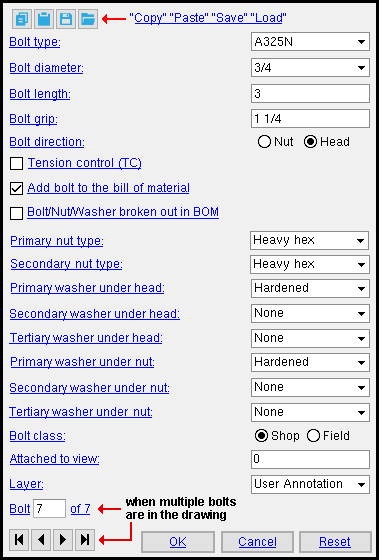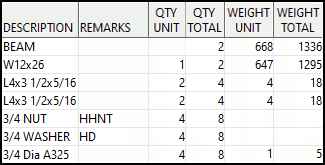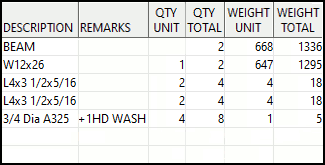The Bolt Edit window ( Drawing Editor )
- Both auto-detailed and user-added bolts can be edited using this window.
To open this window :
- Bolt Add
- Bolt Edit or double-click a bolt
- Edit Bolt (multiple)
Also see :
- Bolts on drawings (topic)
- Grayed out fields (indicate mixed entries or that the field is disabled)
- Multi Items Edit (related window)
page 1 | contents | bolts | top
 " Copy " " Paste " " Save " " Load " buttons
" Copy " " Paste " " Save " " Load " buttons
page 1 | contents | bolts | top
------ Settings ------
Bolt type: A325NG or A325S or A325SX or etc.
Setup: If the bolt type that you want does not appear as a selectable option on this list box's menu (
), you may add it to the menu using the Bolt Specifications in Job Options.
Bolt diameter: The diameter (inches or mm) of the shank of the bolt you are editing or adding.
diameter ![]()
To make an entry: You can type in a diameter, or select a bolt diameter from the menu (
). Diameters listed on the menu come from Home > Project Settings > Job > Bolt Settings > the " Available bolts " list.
Defaults: The default value shown here for the first time you do an Add Bolt operation is the default non-moment " Bolt diameter " for this Job entered in Bolt Settings . For subsequently added bolts, the default is the diameter of the last-added or last-edited bolt -- see " OK ."
Bolt length: The distance (in the primary dimension " Units " or other units ) from inside the bolt head to the tip of the bolt shaft.
length ![]()
Note: Head thickness is not included in the calculation of bolt length because head thickness may vary from manufacturer to manufacturer or even from batch to batch.
Bolt grip: The inside distance (in the primary dimension " Units " or other units ) between the bolt head and nut. If the bolt has washers, then the distance is the inside distance between the washers.
grip ![]()
Bolt direction: Head or Nut . This applies only when you have added a bolt by locating twice at the same location.

|
|
| head | nut |
Select ' Head ' if you want the head of the bolt to be shown on the drawing.
Select ' Nut ' if you want the nut to be shown.
If this box is checked (
), the bolt will be designated as a tension control bolt. A TC bolt is a bolt with a splined end extending beyond the threaded portion of the bolt. The bolt is installed using a special wrench that removes the splined end when the bolt is tightened to the proper tension.
If the box is not checked (
), the bolt bolt will be designated as a non tension control bolt.
Add bolt to the bill of material: ![]() or
or ![]() . This applies to Add Bolt operations only.
. This applies to Add Bolt operations only.
If this box is checked (
), the bolt will be added to the bill of material of the member detail that is your current drawing.
If the box is not checked (
), the bolt will not be added to the bill of material.
Also see: " Bolt class " lets you add shop bolts or field bolts in this way.
Bolt/Nut/Washer broken out in BOM: ![]() or
or ![]() . This option is disabled ( grayed out ) when " Tension control (TC) " is checked (
. This option is disabled ( grayed out ) when " Tension control (TC) " is checked ( ![]() ). The option can apply to any bolt that you can edit on a member detail. Normally only shop bolts are drawn on member details.
). The option can apply to any bolt that you can edit on a member detail. Normally only shop bolts are drawn on member details.
| YouTube video: Bolts, nuts and washers listed separately in BOM .
|
|
||||||
| Screen shots of the BOM are from the bill editor . |
If this box is checked (
), three separate lines in the " Description " column in the member bill of material (BOM) will be used to call out the bolt(s) you are editing. The first line is for the bolt's nut(s) (e.g., 3/4 NUT ). The second line is for the bolt's washer(s) (e.g., 3/4 WASHER ). The third line is for the bolt (e.g., 3/4 Dia A325 ).
If the box is not checked (
) for all bolts in the BOM quantity of bolts, then those bolts are called out as a single line item. Washer information is called out in the " Remarks " column. If more that one nut is associated with the bolt, the extra nut is also called out in the BOM's " Remarks " column.
Defaults: Home > Project Settings > Fabricator > Bolt Detailing Settings > " Bolt/Nut/Washer broken out in BOM sets the default for all bolts in the model. Users can override that default using " Bolt/Nut/Washer broken out in BOM " on the Bolt Edit window in Modeling . The default choice made here matches the choice made in Modeling . If you change the default choice made here, your choice will remain intact until you detail the member again. Auto detailing will override the choice made here with the choice made in Modeling .
Tip: To prevent auto detailing from overridding a change made here, set the " Detail complete " date for this detail.
HOW/2: BOLTS, NUTS, AND WASHERS LISTED SEPARATELY IN BILL (a downloadable .pdf file)
Primary nut type: None or Heavy hex or Heavy square or Jam . The nut that is in the "primary" position is the nut that is closest to the steel being fastened. It is the inside nut.
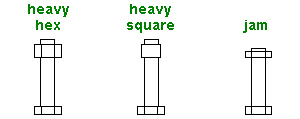
Secondary nut type: None or Heavy hex or Heavy square or Jam . The nut that is in the "secondary" position is the outside nut..
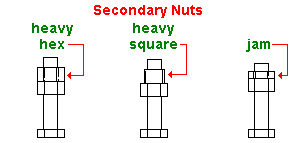
Primary washer under head: None or Flat or Hardened or Bevel or Plate (square plate) or Load (direct tension indicator). The washer under the head of the bolt that is in the "primary" position is the washer that is closest to the steel being fastened.
washer under head ![]()
| type | shape | BOM | setup thickness |
| flat |
|
FL | " Flat washers " |
| hardened |
|
HD | " Hardened washers " |
| bevel |
|
BVL | " Bevel washers " |
| square
plate |
|
PL | " Plate washers " |
| direct tension indicator |
|
DTI | " Direct tension indicator " |
Secondary washer under head: None or Flat or Hardened or Bevel or Plate (square plate) or Load (direct tension indicator). Same as " Primary washer under head ," except that this washer is placed in the secondary position.
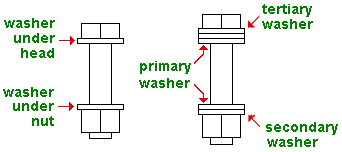
Tertiary washer under head: None or Flat or Hardened or Bevel or Plate (square plate) or Load (direct tension indicator). Same as " Primary washer under head ," except that this washer is placed in the tertiary position.

Primary washer under nut: None or Flat or Hardened or Bevel or Plate (square plate) or Load (direct tension indicator). The washer under the nut that is in the "primary" position is the washer that is closest to the steel being fastened.
washer under nut ![]()
| type | shape | BOM | setup thickness |
| flat |
|
FL | " Flat washers " |
| hardened |
|
HD | " Hardened washers " |
| bevel |
|
BVL | " Bevel washers " |
| square
plate |
|
PL | " Plate washers " |
| direct tension indicator |
|
DTI | " Direct tension indicator " |
Secondary washer under nut: None or Flat or Hardened or Bevel or Plate (square plate) or Load (direct tension indicator).

Tertiary washer under nut: None or Flat or Hardened or Bevel or Plate (square plate) or Load (direct tension indicator).

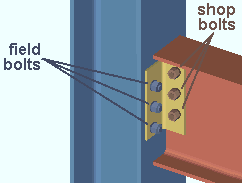
|
In the model, shop and field bolts can be displayed in different colors. Setup for this is done on the Member, Material, Bolt and Weld Colors window. |
' Shop ' bolts are bolts that are to be applied in the shop. If you add a bolt to a member detail in the Drawing Editor and check the box for " Add bolt to the bill of material " and select ' Shop ' as the " Bolt class ," the bolt is added as a shop bolt to the bill of material. This adding to the bill of material has to be done when adding the bolt. I cannot be done by editing the bolt.
' Field ' bolts are sometimes referred to as "site bolts." If you add a bolt to a member detail in the Drawing Editor and check the box for " Add bolt to the bill of material " and select ' Field ' as the " Bolt class ," the bolt is added as a field bolt to the bill of material.
Also see: Bolt " Class " on the Bolt Edit window in Modeling .
Attached to view: A number designating the view that this bolt is attached to. This applies mainly to member details . For instance, a column detail may have a view of face A, face B and face C. It may also have various section views (Section A-A, Section B-B, Section C-C). All graphical objects that are in a particular view are assigned the same number. The only other type of drawing on which you might find multiple views is a submaterial detail .
Assigning the correct number to an object (line, weld symbol, label, etc.), prevents Shorten and Unshorten problems on submaterial details and member details . Automatically detailed submaterial details and member details are the two Drawing Editor drawing types that can have multiple views.
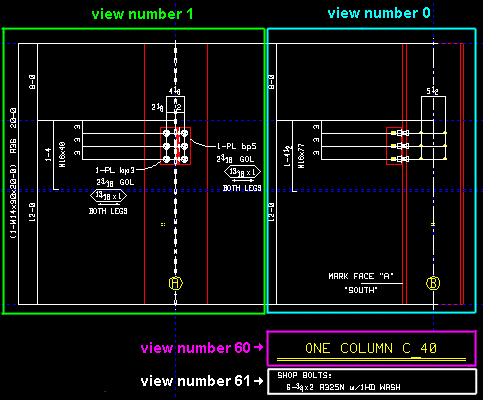
To show a view's number, you can add the X-Y-Z Display to your toolbar. An alternative decoration you can add to display view numbers is the X-Y Dual Show/True Display .

In the Drawing Editor , the X-Y-Z Display shows the view number that the point location target (
) is over.
Troubleshooting: If you Unshorten a drawing then Shorten , only to find that objects are repositioned in a way that seems wrong, the problem might be that the objects are attached to a view that is not the view that they should be attached to. A good troubleshooting method is to select all of the objects that you believe should be attached to the same view, then right-click ( Menu ) and choose " Edit " on the menu . This will open the Multi-Items Edit window. Look at the " Attached to view " field on that window. If that field is gray (shows no view number), then that field has a mixed entry , indicating that objects in your selection have have two or more different view numbers. Entering the desired view number to the " Attached to view " multi-edit field assigns all objects in your selection that one view number.
View number assignment is fairly random. While view numbers assigned during auto detailing are generally the same as the numbers assigned to views in member isolation (or material isolation's edit views mode ), there are cases where that general one-to-one correspondence will not hold. Also, while the main view of a member detail is almost always view 0, the other views are assigned numbers as they are added, and since the order in which views are added is arbitrary, there is little correspondence between a view's number and its type.
How can objects be assigned wrong view numbers? When a user adds an object to a drawing on which there are multiple views (a member detail or a submaterial detail), it is the responsibility of that user to ensure that the object is attached to the correct view. That sounds like an easy thing to do, but it isn't always so simple. Take, for example, a pointer . When a user adds a pointer using Objects > Pointers > Add , the user does not see the Pointer Edit window and therefore does not see the " Attached to view " entry field. Pointers can also be added using Paste , Paste at Original Location , Paste Repeatedly , Paste Special , Paste to Several , Add Standard Detail , Add Standard Detail to Several , Add Weld Combo , Hole Sym Combo , Label Combo , etc. Each of these tools is a different way for users to add a pointer to a wrong view.
Layer: The drawing layer that the bolt you are adding or editing will be drawn on after you press " OK " to close this window. If that layer happens to be hidden (not marked " Show "), the bolt will disappear after the first Redraw .
![]()
Defaults: For an Add Bolt operation, the default selection (
) is the layer that was selected on the Layer Panel before you began the operation. For an Edit Bolt operation, the default selection is the layer that the Drawing Editor object is currently on.
page 1 | contents | bolts | top
For when you edit one bolt and multiple bolts are in the drawing :
Bolt _ of __ (not applicable to Add Bolt or multi-edit) : The number of the one bolt you are editing and the total count of all bolts in your current drawing. You can use the VCR buttons to select a different bolt and edit it while still on this window. When a bolt on a shown layer is selected, it is displayed in green. The selected bolt must be on a shown layer for it to be shown.
|
|
| VCR buttons (first-previous-next-last) for selecting a bolt to edit. |
Note: If you change one bolt, then select a different bolt number, the first bolt remains changed even if you press " Cancel " on this window.
page 1 | contents | bolts | top
"OK" (or the Enter key) closes this window window and completes the Bolt Add or Bolt Edit or Edit Bolt (multiple) operation.
Defaults: When you press " OK ," the settings on this window -- except mixed entries -- become the default settings for the next bolt you Add during this session of the Drawing Editor . Even if all you do is double-click a bolt and press " OK " without making any changes on this window, this window's settings become the defaults for the next-added bolt.
Note: After making changes to this window and pressing " OK ," you can still undo your changes by using Revert or Undo . If you Save to make your changes permanent, you can no longer Revert , but you can still Undo .
"Cancel" (or the Esc key or the ![]() button) closes this window without saving any of the changes you have made. In the case where you selected one bolt for editing but changed more than one bolt, " Cancel " only cancels the changes made to the bolt whose number is currently selected as the " Bolt _ of __ ."
button) closes this window without saving any of the changes you have made. In the case where you selected one bolt for editing but changed more than one bolt, " Cancel " only cancels the changes made to the bolt whose number is currently selected as the " Bolt _ of __ ."
Defaults: The settings on this window do not become the defaults for new bolts if you press " Cancel " to close this window (unless you used " Bolt _ of __ ").
Tip 1: If you used " Bolt _ of __ " to edit more than one bolt, then Undo (after you have closed this window) does undo all those changes.
Tip 2: If you double-click a bolt just to review it and don't want to set the defaults for to-be-added bolts, the best way to close this window is to press " Cancel. "
"Reset" undoes changes made to the bolt currently selected as the " Bolt _ of __ ." The window remains open.
